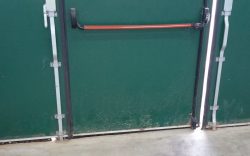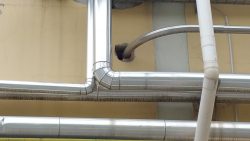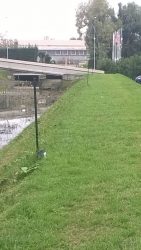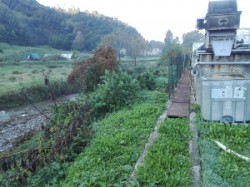Due concetti sempre più uniti
Pest proofing è un termine inglese che nel senso comune significa l’insieme delle misure che si devono adottare per impedire la penetrazione e la proliferazione degli infestanti all’interno degli edifici.
Pest sta indicare genericamente “infestanti” e proofing può essere associato ad un termine che indica “impermeabile” .
Queste due parole si riferiscono ad un ambiente inviolabile dagli infestanti.
Per maggiore precisione qualora si volesse focalizzare questo aspetto esclusivamente sui roditori si può parlare di Rat Proofing.
Le restrizioni sempre maggiori che caratterizzano il nostro lavoro relativamente all’uso di esche rodenticide,sistemi di trappolaggio (vedi Nord Europa) ed utilizzo di prodotti insetticidi per la disinfestazione non ci consentono di rimandare oltre tutte quelle azioni di miglioramento strutturale che devono essere effettuate nelle Aziende Alimentari.
Se fino ad oggi l’idea che fosse superfluo non intervenire con opere di esclusione (molto più costose rispetto al prezzo di un erogatore o trappola da aggiungere od intervento di disinfestazione nelle aree perimetrali esterne) oggi dobbiamo dire con forza che questa prospettiva è inderogabile.
Esistono testi autorevoli che prendono in esame questi aspetti di cui tiene conto chi si occupa della progettazione e costruzione di strutture destinate ad ospitare Aziende Alimentari in quanto come ben sappiamo un conto è prevedere le caratteristiche strutturali al momento della costruzione mentre un altro conto è intervenire su strutture a volte obsolete o concepite secondo altri criteri più legati alla funzionalità operativa.
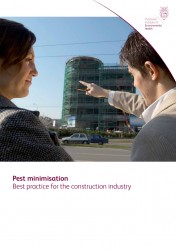
Pest Minimisation Best Practice
Il Tecnico della Ditta di Disinfestazione dovrà con sempre maggior impegno segnalare tutti quei punti critici di possibile intrusione e l’Azienda Alimentare deve comprendere che questa azione preventiva viene fatta nel suo proprio interesse.e non rappresenta un capriccio del disinfestatore.
Il Tecnico fornisce queste informazioni durante l’esecuzione del servizio e viene già compensato per questo, quindi bisogna cogliere il valore aggiunto che egli può dare conoscendo a fondo le abitudini e l’etologia dell’infestante e può prevedere a ragion veduta cosa può essere migliorato.
La Ditta di Pest Control ha ben presente le conseguenze derivanti da una situazione critica che di fatto espone le parti ad un rischio molto grave che può provocare un Danno sia Diretto che Indiretto dovuto alla Contaminazione Biologica e Fisica di un infestante nell’alimento.
Per cui il nostro focus si deve concentrare sui punti deboli che possono essere presenti relativamente alle zone di accesso,alcune macroscopiche ed evidenti, altre meno, e che possono essere utilizzate dagli infestanti per introdursi all’interno della struttura.
Ad un occhio esperto si evidenziano spesso questi punti deboli, tra i quali possiamo elencare:
– Bande antintrusione alle porte e ai portoni poco efficienti
– Zanzariere presenti e integre
– Cavidotti schermati e tubazioni da tombini esterni opportunamente sigillate
– Bocche di aerazione grigliate
– Tubazioni e condotte di impianti termici sigillate
– Pavimentazione esterna presente e senza avvallamenti (no pozzanghere)
– Sfalcio costante dell’erba nelle porzioni di prato perimetrale (se presente)
– Zona rifiuti esterna correttamente gestita
Nella progettazione dell’impianto di monitoraggio infestanti e nella valutazione di quanto deve essere fatto per la corretta manutenzione delle aree esterne deve essere considerata anche quella che in gergo tecnico viene definita come CAPACITA’ PORTANTE dell’area dove insiste il sito produttivo,intesa come capacità dell’ambiente di permettere la proliferazione di infestanti (esempio disponibilità di acqua,cibo,possibilità di nidificazione) e valutare come l’Azienda possa’ intervenire per ridurre questa capacità portante.
Per concludere, il Pest proofing può comprendere anche tutte quelle buone pratiche che durante le attività lavorative tendono a minimizzare se non ad escludere i rischi da intrusione come per esempio:
– Porte e portoni aperti durante i periodi di inattività.
– Chiusura dei contenitori per rifiuti e non lasciare avanzi o residui di cibo durante le pause.
– Contribuire al mantenimento di un buon livello di pulizia
– Segnalare ogni discostamento da livelli conformi nei punti sovraesposti.
L’ultimo punto in elenco indica che l’integrità strutturale deve essere costantemente monitorata.
Romani Disinfestazioni Srl è organizzata per valutare insieme al Cliente tutte le operazioni da effettuare per migliorare e mantenere efficiente il sistema di protezione contro le intrusioni da infestanti.
Rosi Norman
Romani Disinfestazioni Srl LUCCA Tel 0583-955344 Cell 337-1238029
Controllo Qualità
Deratization and pest proofing two united concepts
Pest proofing is a word which in common sense means all the measures that must be taken to prevent the penetration and proliferation of pests in buildings.
These two words refer to an inviolable environment from pests. To be more precise if you want to focus solely on rodents we can talk of Rat Proofing.
The always growing restrictions that characterize our work regarding the use of rodenticide baits, trapping systems (see Northern Europe) and use of insecticides products for disinfestation didn’t allow us to postpone those actions of structural improvement that must be made in food manufacture.
If until now the idea that it was unnecessary to intervene with works of exclusion (much more expensive than the price of a dispenser, a trap to be added or a disinfestation operation in the external perimeter areas) today we must say emphatically that this perspective is final .
There are authoritative texts that examine these aspects that takes into account those involved in the design and construction of facilities designed to host food production because as we all know one thing is to predict the structural characteristics at the time of construction and another thing is to act ,on sometimes obsolete structures or designed, according to an operating functionality criteria.
The technician of the pest control company will focus the report to all those critical points of possible intrusion and the food company must understand that this preventive action is done in its own interest and not for the exterminator’s whim.
The technician provides this information during the execution of the service and is already up for it, so you have to understand the added value that he can give of knowing the habits and the pest ethology and can predict ,due consideration, what can be improved.
The pest control company is well aware of the consequences of a critical situation that actually exposes the parties to a very serious risk that can cause damage both directly and indirectly due to biological and physics contamination of a pest in the food.
So our focus is on the weak points that may be present in relation to access areas, some glaring and obvious some others less, and that can be used by the pests to get inside the structure.
To a trained eye these weaknesses will be often highlighted, among which we can list:
- Inefficient intruder bands on gates and doors
- Mosquitos nets present and intact
- Shielded conduits, external manholes and pipes suitably sealed
- Grills on air vents
- Sealed thermal plants pipes and ducts
- External flooring present with no depressions (no puddles)
- Costant grass mowing on the perimeter (if any)
- External waste zone properly managed
In designing the plan for pest monitoring ,and evaluation of what is required for proper maintenance, of the outdoor areas it must also be considered in technical jargon is known as CARRYING CAPACITY area where is situated the production site, meaning the environmental ability to allow the proliferation of pests (eg. availability of water, food and nesting opportunities) and evaluate how the company can take action to reduce this carrying capacity.
Finally, the Pest proofing can include all those good practices during work activities to minimize or even to exclude the risks of intrusion such as:
- Doors and gates open during inactivity periods.
- Closure of waste containers and don’t leave leftovers or food residues during breaks.
- Contribute to maintaining a good level of cleanliness
- Report any deviation from compliance levels in the points above.
The last point in the list indicates that the structural integrity must be constantly monitored.
Romani Pest Control Srl is organized to assess with the customer all the steps to take to improve and maintain efficient system of protection against intrusion by any kind of pests.
Rosi Norman
Romani Disinfestazioni Srl LUCCA Tel 0583-955344 Cell 337-1238029
Controllo Qualità


